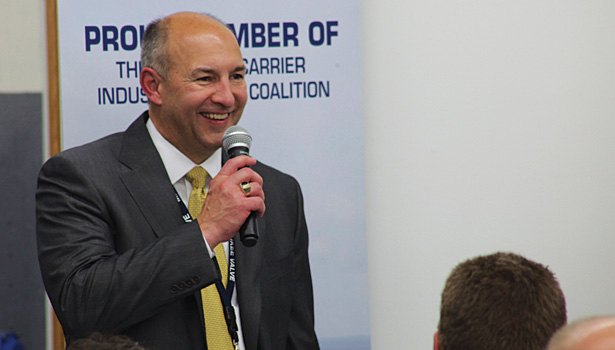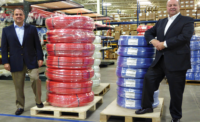pme: What motivated Milwaukee Valve Co. to take a leadership position on low-lead products?
RG: Bronze and brass are a huge part of what we do. They are an integral part of our broad product offering — everything from gate, globe, check and ball valves, including our unique Butterball Valve. We have a vested interest in the success of these products, and we have facilities, foundries and forging operations to manufacture them. We wanted the marketplace to understand our desire to successfully introduce these new products.
pme:What else needs to be done to educate plumbing and mechanical engineers on low-lead products?
RG: The educational process will continue for a long time. Low-lead products are still quite unknown to most people in the industry. Many engineers in particular don’t really understand exactly where and how to use them. We’ll continue with our webinars and other efforts to educate them.
pme: Is installation of lead-free products an issue for engineers?
RG: There’s a lot of talk about the solder. From the very beginning, we have not recommended a specific solder to use on our lead-free valves. The reason is that we have tested our valves with just about every acceptable solder on the market. We’ve not had a problem with any of them. We attribute this broad success to our robust product design.
pme: Besides low-lead products such as UltraPure Valves, what trend in valve technology excites you the most?
RG: We really like our butterfly valve product offering. We seem to have an endless configuration of potential butterfly valves with our liners, discs and different types of materials. We see that offering growing every year. Our high-performance butterfly valve has a tremendous market potential because we’re still at the infancy level. Even though it has grown quite a bit for us overall, we’re a small player in that market compared with our primary competitors. We’re about to introduce a fire-safe version of that product, too.
pme:What can engineers expect to see from Milwaukee Valve in the next 12 months?
RG:Beyond the fire-safe version of our high-performance butterfly valve, we are continuing to expand the size range of the low-lead and UltraPure products we’re offering. We’re finding that many engineers would like as many products as possible to be made out of the low-lead material. So, they will see more sizes and approvals from us.
Similarly, we’ll be adding more sizes to our UltraPress line of press-end valves. We’ve had great success with that line in the last five years. We’re coming out with a new line of press fittings this year that converts any bronze NPT valve we make into a press-end valve simply by adding our fitting. On the marine side, we are expanding our product offering to include nickel/aluminum/bronze high-performance valves.
pme:Where do you see business opportunities for engineers?
RG: We don’t believe the commercial markets have come all the way back since the recession occurred in 2008 and 2009. We and most of our commercial valve competitors had a tough time in 2009. For guys on the plumbing side, the slowdown started in 2008. We certainly hope we’ll see more investment in office building construction. The hospital and health-care market has been very good for us. Data centers have been very good. We expect both those sectors to continue to grow. Schools have been pretty good, too.
But we really had hoped to see more general business construction at this point. We started the year very strong and it lagged a little in the second quarter. We’re hearing about a lot of pent-up demand and possibly a great fourth quarter, and we hope that will be the case.
pme:In what new ways is Milwaukee Valve connecting with engineers?
RG:We have had good success with the webinar we did on low-lead products http://tinyurl.com/k3dcj8r. We’re developing another webinar on valve specification. We’ll do more webinars in the future. We’re redesigning our website (www.milwaukeevalve.com) to make sure we’re up to date with social media and other trends.
pme: What is the common denominator in the products you manufacture for two of your primary customer groups — mechanical contractors and U.S. Navy ship builders?
RG:The biggest similarity is that we start with the same manufacturing facility for everything we do in bronze. This means we have the same bronze foundry, and the standards for our bronze foundry come from the stringent requirements the U.S. Navy places on us. Everything is done the same way from a manufacturing standpoint. We have more than 80 machine tools, most of which are computer numerically controlled equipment including robotics in our facility.
We put them in manufacturing cells with a minimum of two pieces of CNC equipment per cell. Many of these cells can run interchangeably to make marine and commercial/industrial products. But even the cells dedicated to one type of product use similar equipment to the other type. The machine operators are cross-trained to go across different work cells. This gives us a lot of flexibility. The marine business is the base of our operations in the United States.
pme: Why is it important for Milwaukee Valve to get involved in industry organizations such as MCAA?
RG: We view it as part of our responsibility. We require the support of the engineers in the industry. In order to get their support, we do a lot of marketing, but in particular we support the organizations that they support. MCAA is one of them, and ASPE and the American Supply Association are two other industry associations we support. We just think that you can’t be a part of this industry and then not support the primary industry leaders.
pme: What do you see as Milwaukee Valve’s greatest accomplishment or most distinguishing feature?
RG:Being in business for 110 years is one of our many accomplishments. From a strategic standpoint, we made a decision about 15 years ago that we wanted to maintain our position as a manufacturer of valves and not just be another link of distribution in the chain of valve manufacturers. Not every valve company has total control of its operations.
For those products that we couldn’t make in the United States, we’ve invested in overseas operations to manufacture them. We made the decision to be vertically integrated and maintain control from design through manufacture, assembly and testing, and we have one distribution facility. Taking control of the process, investing vertically and integrated operations set us apart from many of our competitors. That’s our greatest strength.
pme:If you had one piece of business advice to give to engineers, what would it be?
RG: The world is changing quickly. We have a whole new world ahead of us with the introduction of low-lead products that have revolutionized the bronze and brass side of the business, after a hundred years of alloys that we all knew. We believe Milwaukee Valve has done a very good job of introducing these products and have some of the best products in the marketplace. But there are differences in products, and contractors need to understand what they are.
Another thing that has changed dramatically in the last five years is the marketplace for materials and what they cost. The explosion of copper prices over the years — and we saw it with nickel as well — has created enormous swings in the cost of doing business, as has the continued appreciation of the Chinese currency against the U.S. dollar. Throw in health care, and all these skyrocketing cost factors have placed enormous pressure on manufacturers.
So, engineers should keep an eye on the economic indices and attend as many industry meetings and webinars as possible to learn about what is actually happening in the marketplace.
HELPFUL LINKS:




